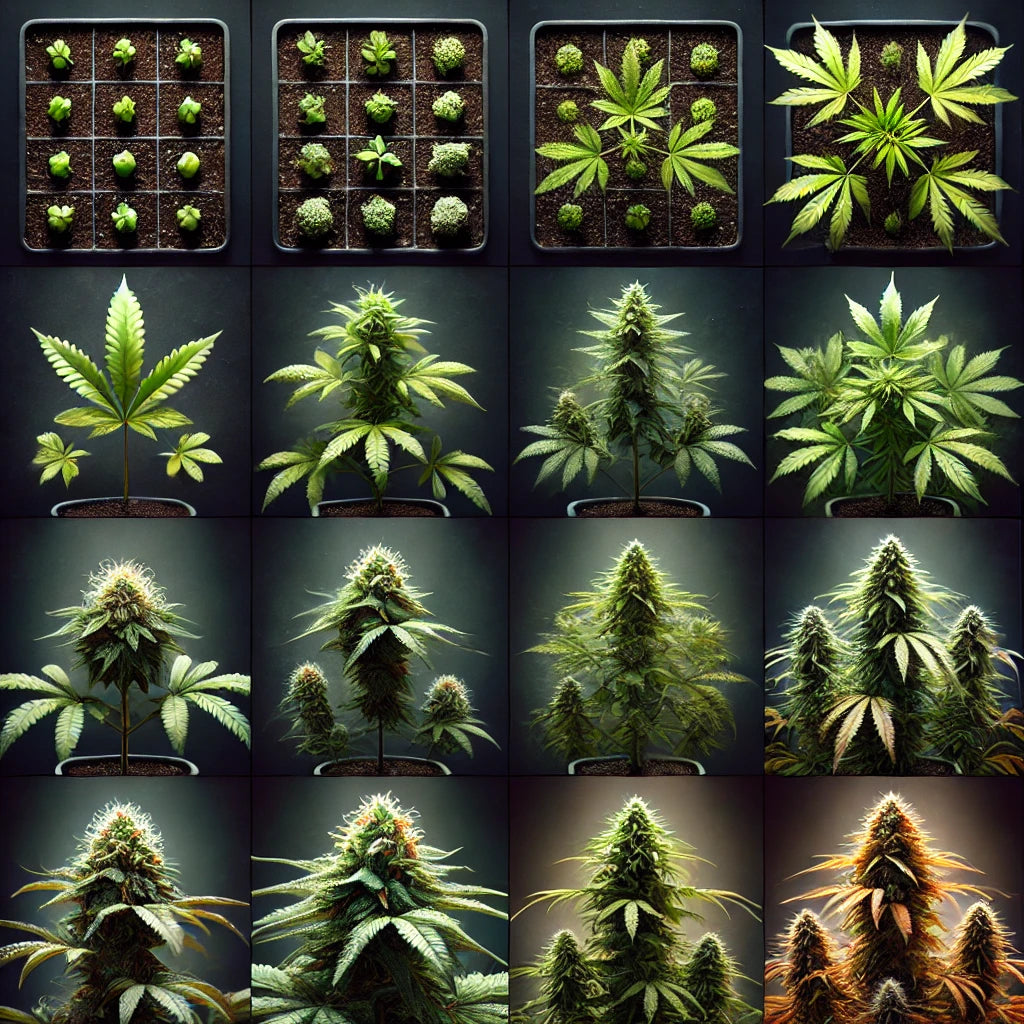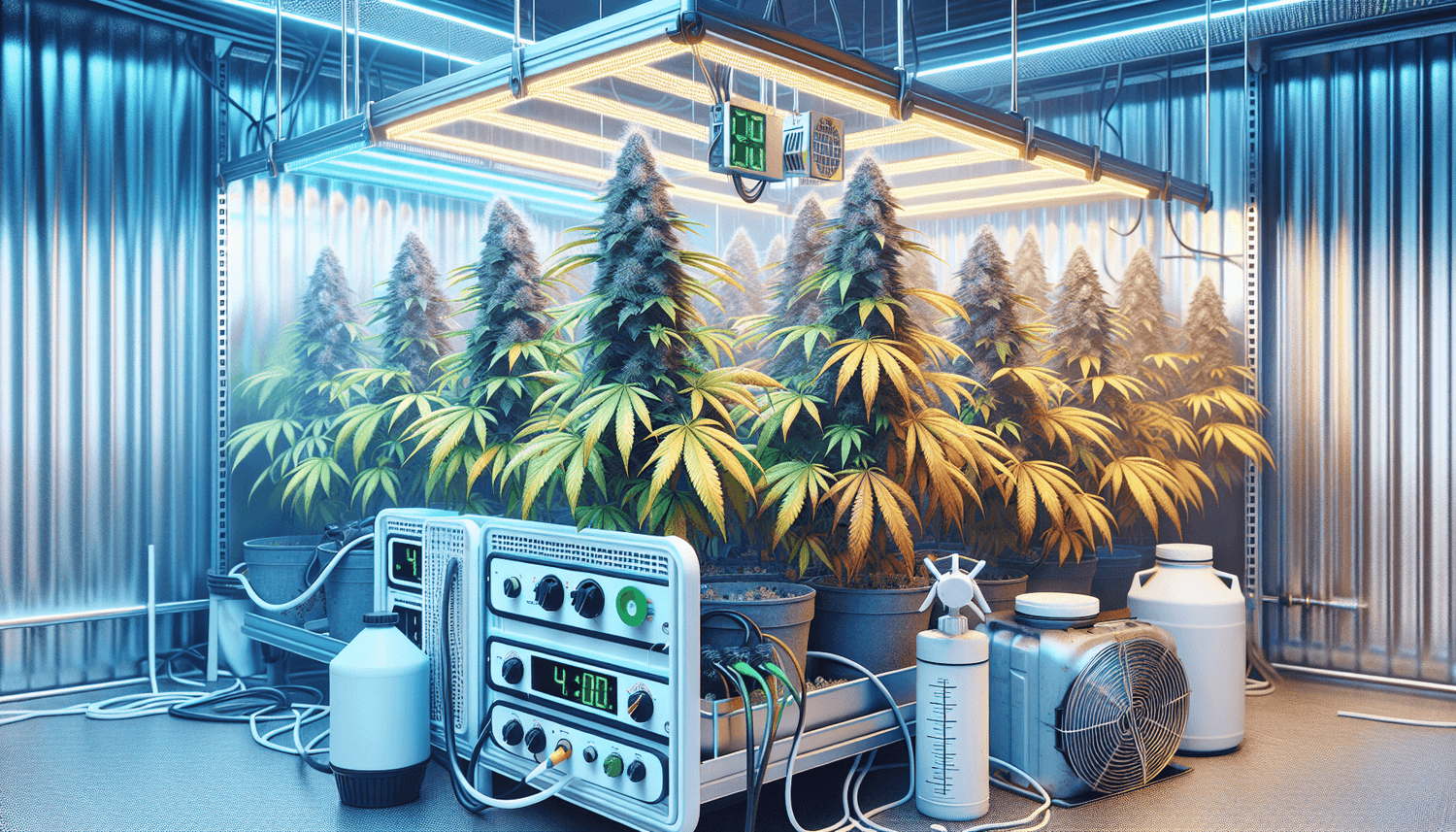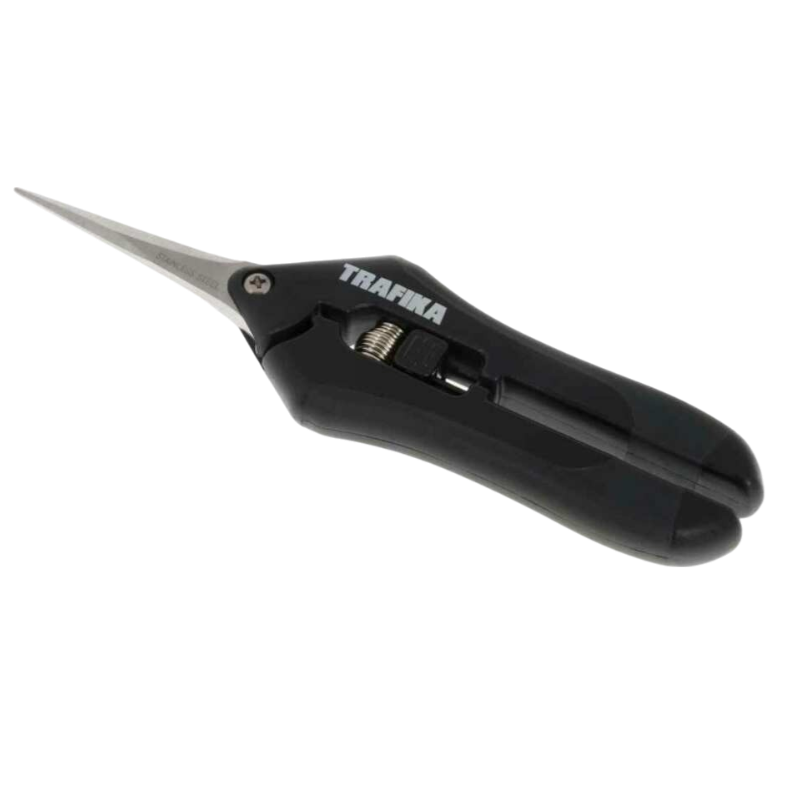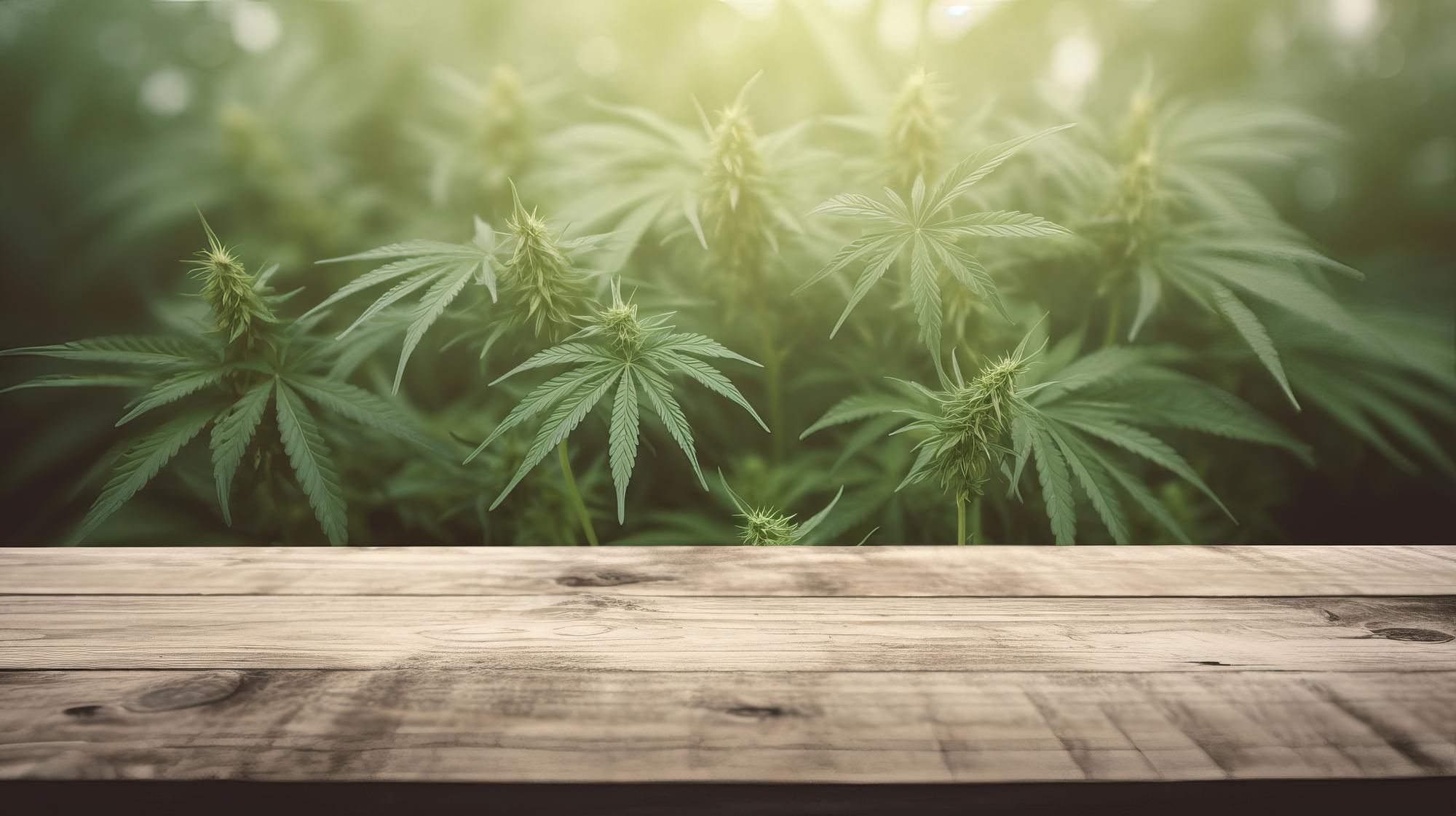1. Identify the most common nutrient deficiencies in cannabis
When growing cannabis in a grow tent, it is crucial to identify nutrient deficiencies early on. These can significantly affect the growth and yield of your plants. Let's take a closer look at the most common symptoms:
Nitrogen deficiency
Nitrogen is essential for growth and leaf development. If there is a deficiency, you will notice:
- Yellowing of the lower, older leaves
- Slower growth
- Smaller leaves than normal
Pay particular attention to the leaf color. Uniform yellowing from bottom to top is a clear warning sign of nitrogen deficiency.
Phosphorus deficiency
Phosphorus plays an important role in energy transfer and root development. Typical signs are:
- Dark green or purple leaves
- Delayed flowering stage
- Weak trunks and roots
A phosphorus deficiency can drastically reduce yields, especially during the flowering phase, so react quickly if you notice these symptoms.
Potassium deficiency
Potassium regulates many metabolic processes in the plant. A deficiency is indicated by:
- Brown or yellow spots on the leaves
- Rolled leaf edges
- Increased susceptibility to diseases and pests
Potassium deficiency often occurs in combination with other nutrient deficiencies. Close observation of your plants is therefore essential.
Magnesium deficiency
Magnesium is a central component of chlorophyll. If you have a deficiency, you will see:
- Yellowish discoloration between the leaf veins
- Death of leaf edges
- Reduced photosynthesis performance
Magnesium deficiency often occurs in the late growth and early flowering phases. Early detection can significantly improve yield.
| nutrient | Main symptoms | Affected plant parts |
|---|---|---|
| Nitrogen | Yellowing | Lower leaves |
| phosphorus | Dark/purple discoloration | Whole plant |
| potassium | Brown spots | Leaf margins |
| magnesium | Chlorosis between leaf veins | Middle to upper leaves |
Keep an eye on these symptoms and act quickly if you notice them. In the next section, you will learn how to identify the causes of nutrient deficiencies in your grow tent.
2. Detect the causes of nutrient deficiency in the grow box
Now that you know the symptoms of nutrient deficiencies, it is important to understand their causes. Various factors can lead to nutrient deficiencies in a grow tent. Let's take a closer look at the most common reasons:
Unbalanced nutrient composition
Often, an incorrect fertilizer mix is the main reason for nutrient deficiencies. Cannabis requires different nutrient ratios in different growth phases. An imbalance can quickly lead to deficiency symptoms.
Pay particular attention to the NPK ratio (nitrogen, phosphorus, potassium) of your fertilizer:
- Growth phase: Higher nitrogen content (e.g. 3-1-2)
- Flowering phase: More phosphorus and potassium (e.g. 1-3-2)
Incorrect pH values
The pH value of the substrate plays a crucial role in nutrient absorption. If it is outside the optimal range, the plants can no longer absorb certain nutrients. The following applies to cannabis:
| Cultivation method | Optimal pH range |
|---|---|
| Earth | 6.0 - 7.0 |
| Hydroponics | 5.5 - 6.5 |
Check the pH value of your substrate and water regularly. Even small deviations can have a big impact.
Overfertilization and nutrient blockages
Paradoxically, over-fertilization can also lead to nutrient deficiencies. If you add too many nutrients, they can accumulate in the substrate and block the absorption of other nutrients. This leads to so-called nutrient blockages.
Observe your plants closely. If you notice signs of deficiency despite regular fertilization, over-fertilization could be the cause.
Environmental factors in the grow box
The conditions in your grow box significantly influence nutrient uptake:
- Temperature: Temperatures that are too high or too low disrupt nutrient absorption.
- Humidity: Too low humidity can impair transpiration and thus the transport of nutrients.
- Lighting conditions: Insufficient light slows growth and nutrient uptake.
Make sure your grow box offers optimal conditions. Good ventilation and constant temperatures between 20-28°C are ideal.
Root problems
Healthy roots are the basis for effective nutrient absorption. Problems in the root area can quickly lead to deficiency symptoms:
- Overwatering: Leads to oxygen deficiency in the root area
- Underwatering: Prevents the absorption of nutrients
- Root diseases: Impair the functionality of the roots
Make sure you have a balanced watering management and check the condition of the roots regularly, if possible.
By keeping an eye on these possible causes, you can effectively prevent or quickly remedy nutrient deficiencies in your cannabis grow box. In the next section, we will show you how you can specifically combat nutrient deficiencies.
3. Quick solutions: How to effectively correct nutrient deficiencies
Have you discovered nutrient deficiencies in your cannabis grow box? Don't panic! With the right measures, you can quickly get the situation under control. Here you can find out how to proceed with various nutrient deficiencies:
General procedure
Before you take specific action, you should take the following steps:
- Identify the deficiency accurately based on the symptoms.
- Check the pH of the substrate and adjust it if necessary.
- Check the environmental conditions in your grow box.
- Make sure the problem is not caused by overwatering or underwatering.
Specific solutions for common nutrient deficiencies
Correct nitrogen deficiency
If you have a nitrogen deficiency, you can quickly remedy it:
- Add a nitrogen-rich fertilizer (e.g. blood meal or liquid nitrogen fertilizer).
- Increase the dosage of your NPK fertilizer slightly.
- Use organic additives such as compost tea or worm castings.
Important: Do not overdo the nitrogen supply, especially during the flowering phase!
Compensate for phosphorus deficiency
To correct a phosphorus deficiency, you can take the following steps:
- Use phosphorus-rich fertilizers (e.g. bone meal or special P-boosters).
- Increase the temperature in your grow box slightly, as phosphorus is better absorbed in warmer temperatures.
- Check the pH value - phosphorus is best absorbed in the slightly acidic range.
Correct potassium deficiency
If you have a potassium deficiency, these measures will help:
- Use potassium-rich additives such as wood ash or molasses (use carefully!).
- Use special K-boosters, especially during the flowering phase.
- Make sure to water adequately, as potassium is water soluble.
Compensate for magnesium deficiency
A magnesium deficiency can often be easily remedied:
- Water your plants with an Epsom salt solution (1 teaspoon per liter of water).
- Use dolomite lime, which provides both magnesium and calcium.
- Use foliar fertilizers containing magnesium for rapid absorption.
Emergency measures in case of acute nutrient deficiency
In critical situations, you can use foliar fertilizers. These are absorbed directly through the leaves and work faster than soil fertilizers. Please note:
- Spray the solution finely onto the underside of the leaves.
- Apply foliar fertilizer only when the lights are off to avoid burns.
- Repeat application after 3-4 days until symptoms improve.
| Nutrient deficiency | Quick solution | Long-term measure |
|---|---|---|
| Nitrogen | Liquid N-fertilizer | Adjustment of the NPK ratio |
| phosphorus | P-Booster | Optimize pH value |
| potassium | K-Booster | Balanced fertilization |
| magnesium | Epsom salt solution | Regular Mg supplementation |
Remember: less is often more. Start with a small dosage and increase it slowly to avoid over-fertilization. Watch your plants closely and give them time to respond to the treatment. With a little patience and the right measures, you will soon see your cannabis plants blooming in full splendor again.
4. Prevention is better than cure: Optimal fertilization for your plants
In order to avoid nutrient deficiencies in your cannabis grow box from the outset, a well-thought-out fertilization strategy is essential. With the right approach, you can create optimal conditions for healthy, productive plants. Here you can find out how to perfect your fertilization:
Understanding the basics of cannabis fertilization
Cannabis has different nutritional needs in different growth phases. Adapted fertilization is therefore crucial:
- Growth phase: High nitrogen requirement for strong leaf growth
- Flowering phase: Increased need for phosphorus and potassium for flower formation
- Last weeks: Reducing nutrients for better taste
Making the right fertilizer choice
There are different types of fertilizers that are suitable for cannabis:
| Fertilizer type | Advantages | Disadvantages |
|---|---|---|
| Mineral fertilizer | Fast acting, precise dosing | Can easily be overdosed |
| Organic fertilizer | Gentle, promotes soil organisms | Slower effect |
| Liquid fertilizer | Easy to use, easy to mix | Regular use necessary |
| Long-term fertilizer | Continuous nutrient delivery | Less flexible to adapt |
Choose a fertilizer that suits your growing method and your level of experience. For beginners, special cannabis fertilizer sets that are already tailored to the different growth phases are often recommended.
Correctly dose fertilizer
The correct dosage is crucial to avoid over- or under-fertilization:
- Start with about 25-50% of the manufacturer's recommended dose.
- Increase the amount slowly if the plants respond positively.
- Watch your plants closely for signs of over- or under-fertilization.
- Adjust fertilization to the growth phase.
A good tip: Keep a fertilization log to keep track and repeat successful strategies.
Keep an eye on pH and EC values
The pH value and the EC value (electrical conductivity) are crucial for optimal nutrient absorption:
- Regularly measure the pH value of your substrate and irrigation water.
- Keep the pH in the optimal range (soil: 6.0-7.0, hydroponics: 5.5-6.5).
- Monitor the EC value to avoid over-fertilization.
- Adjust the nutrient concentration to the EC value (ideally between 0.8-2.0 mS/cm, depending on the growth phase).
Supplementary nutrients and boosters
In addition to the main nutrients (NPK), cannabis plants benefit from additional micronutrients and boosters:
- Calcium and magnesium: Important for cell structure and chlorophyll formation
- Silicon: Strengthens plant structure and increases stress resistance
- Enzymes and bacteria: Promote root health and nutrient uptake
- Flowering boosters: Can increase yield in the late flowering phase
Use these additives sparingly and specifically to provide optimal support to your plants.
Regular plant inspection
A forward-looking fertilization strategy also includes continuous monitoring of your plants:
- Check the general appearance of your plants daily.
- Pay attention to color changes, growth rates and leaf structure.
- React early to the first signs of nutrient deficiencies or excesses.
- Adapt your fertilization strategy flexibly if necessary.
With these strategies for optimal fertilization, you lay the foundation for healthy, strong cannabis plants in your grow box. Remember: every plant is different, and the perfect fertilization often requires some experience and sensitivity. Stay patient, learn from your experiences and continually adapt your methods. This way, you will soon become a master in the art of cannabis fertilization!
5. Expert tips: Perfect nutrient supply for maximum yield
To take your cannabis cultivation to the next level, we have compiled some expert tips. These advanced strategies will help you optimize the nutrition of your plants and maximize yields.
Leaf analysis for precise nutrient determination
Professionals rely on leaf analysis to determine the exact nutrient requirements of their plants:
- Send leaf samples to specialized laboratories.
- Get detailed information about macro and micronutrients.
- Adjust your fertilization precisely based on the results.
This method enables a tailored nutrient supply and helps to detect subtle deficiencies at an early stage.
Use of mycorrhizal fungi
Mycorrhizal fungi form a symbiotic relationship with cannabis roots and significantly improve nutrient uptake:
- Increases the absorption of phosphorus and other nutrients.
- Improves water absorption and drought resistance.
- Strengthens the immune system of plants.
Add mycorrhiza preparations when repotting or directly into the substrate to take advantage of this natural booster.
Advanced fertilization techniques
Foliar spraying
Spraying the leaves with nutrient solutions can be very effective in certain situations:
- Ideal for quickly correcting micronutrient deficiencies.
- Particularly effective in the absorption of iron and manganese.
- Use only with the lights off to avoid burns.
Fertigation
Fertigation combines irrigation and fertilization:
- Enables precise and even nutrient distribution.
- Saves time and reduces workload.
- Particularly effective in larger cultivation systems.
Use of plant hormones and growth regulators
Advanced growers sometimes use plant hormones to influence specific aspects of growth:
| Active ingredient | effect | Application |
|---|---|---|
| Auxins | Promote root growth | For cuttings and young plants |
| Gibberellins | Increase elongation growth | To increase plant size |
| Cytokinins | Promote branching | For bushier plants |
Caution: The use of these substances requires experience and should be done with caution.
Optimization of the microclimate
A perfect microclimate supports optimal nutrient absorption:
- Keep humidity at 40-60% during flowering.
- Ensure good air circulation to promote nutrient transport.
- Optimize CO2 concentration for maximum photosynthesis and nutrient utilization.
Water quality and nutrient uptake
The quality of your irrigation water significantly influences nutrient absorption:
- Use filtered or reverse osmosis water for maximum control.
- Adjust the water hardness to the needs of your plants.
- Pay attention to the water temperature – ideally room temperature for best absorption.
Crop steering for maximum yield
Crop Steering is an advanced technique for controlling plant growth:
- Manipulate watering cycles to encourage vegetative or generative growth.
- Strategically adjust EC values and watering frequency according to the growing season.
- Use dry periods to stimulate root growth and nutrient uptake.
This method requires precise monitoring and experience, but can lead to significant yield increases.
Conclusion
Implementing these expert tips requires experience, patience and keen observation. Not all techniques are suitable for every grow, so it's important to proceed step by step and carefully observe how your plants respond. Over time, you'll develop a feel for which methods work best in your grow box.
Remember: the key to success is to continually adapt and optimize your cultivation techniques. Experiment carefully, learn from your experiences and share your knowledge with other growers. This will not only increase your yields, but also make you a true cannabis cultivation expert.

















